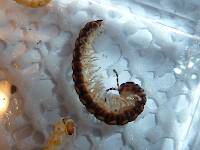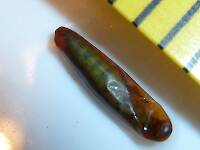
Salmonflies
Pteronarcys californica
The giant Salmonflies of the Western mountains are legendary for their proclivity to elicit consistent dry-fly action and ferocious strikes.
Featured on the forum

This one pretty clearly keys to Kogotus, but it also looks fairly different from specimens I caught in the same creek about a month later in the year. With only one species of the genus known in Washington, I'm not sure about the answer to this ID.

Troutnut is a project started in 2003 by salmonid ecologist Jason "Troutnut" Neuswanger to help anglers and
fly tyers unabashedly embrace the entomological side of the sport. Learn more about Troutnut or
support the project for an enhanced experience here.
Martinlf on Apr 13, 2008April 13th, 2008, 5:20 am EDT
OK, if my other recent posts doesn't have some scratching their heads, or just picking themselves off the floor of their tying room, this one will do it for sure.
Someone recently suggested elsewhere that for really big generic nymphs that imitate various worms* one can not only use latex prophylactics, but also wool yarn. Unable to easily find wool yarn of the right color for my mega Walt's Worms (John W can attest to their effectiveness in high spring run-off conditions; take note WI contingent, for when all that white stuff melts.) I came up with the following concept.
Take some undyed honeybug yarn (Despite previous jabs at the venerable honeybug and its cousin the sinking inchworm, I must observe that I recently saw one of the jabbers with a green weenie on the end of his line.) and dye it Walt's Worm tan, or as close as you can get. Rit taupe dye isn't too far off, and tan will work in a pinch. Select a hook. The recently alluded to forum noted that scud hooks invert when weighted, and thus become less prone to hanging on underwater obstructions, so I've been using a big Daiichi 1130 until my barbless scud hooks arrive. Add a bead or not. (Sorry Gonzo.) As per the "shot or not" thread, I've been using tungsten beads. Wrap lead or lead-free wire around the shank to taste, push the wraps up to the bead, then tie in some fluorescent red thread in behind the weighting wire wraps, over wrap them with the thread to bind the wire in, coat the wire with nail polish if it's lead, then wrap the thread back to where the body will begin. Here tie in a black thread still attached to a bobbin and let it hang. With the red thread secure a length of tan honeybug yarn at this point as well, advance the red thread to the tie off point at the head, just behind the eye or the bead (if added), wrap the honeybug yarn to the tie off point and tie it off, throwing in a whip finish or half hitches at the least. You now have a honeybug with black thread extending from its derriere. Here's the slick part. Dub the black thread with tan hare's ear (Walt's Worm Fur, that is). Spiral the dubbed thread tightly through the Honeybug yarn, ribbing the fly with it, up to the tie off point. Use the red thread to tie off the black dubbed thread, and whip finish. This is to create a hot spot, an attractor element in this otherwise highly specific imitative pattern. Finally use your velcro dubbing brush to tease out the hare's ear, making the fly fuzzy.
Yes, go ahead and laugh, but the trout weren't laughing yesterday, I can tell you. And I know some of you out there will find this a very interesting development on the honeybug tutorials offered in the past.
*Jason really needs a footnote function. I would add the following note on the scientific names of worms taken from another website. Somehow the observations seemed to fit with the recent discussion of the condom fly: 'The name "Apporectodea Turgida" means "pasture worm," but "Turgida" means to swell out.' Please observe that this was not taken from an X-rated site:
http://www.wausau.k12.wi.us/ribmtn/grade5/page9.html
Someone recently suggested elsewhere that for really big generic nymphs that imitate various worms* one can not only use latex prophylactics, but also wool yarn. Unable to easily find wool yarn of the right color for my mega Walt's Worms (John W can attest to their effectiveness in high spring run-off conditions; take note WI contingent, for when all that white stuff melts.) I came up with the following concept.
Take some undyed honeybug yarn (Despite previous jabs at the venerable honeybug and its cousin the sinking inchworm, I must observe that I recently saw one of the jabbers with a green weenie on the end of his line.) and dye it Walt's Worm tan, or as close as you can get. Rit taupe dye isn't too far off, and tan will work in a pinch. Select a hook. The recently alluded to forum noted that scud hooks invert when weighted, and thus become less prone to hanging on underwater obstructions, so I've been using a big Daiichi 1130 until my barbless scud hooks arrive. Add a bead or not. (Sorry Gonzo.) As per the "shot or not" thread, I've been using tungsten beads. Wrap lead or lead-free wire around the shank to taste, push the wraps up to the bead, then tie in some fluorescent red thread in behind the weighting wire wraps, over wrap them with the thread to bind the wire in, coat the wire with nail polish if it's lead, then wrap the thread back to where the body will begin. Here tie in a black thread still attached to a bobbin and let it hang. With the red thread secure a length of tan honeybug yarn at this point as well, advance the red thread to the tie off point at the head, just behind the eye or the bead (if added), wrap the honeybug yarn to the tie off point and tie it off, throwing in a whip finish or half hitches at the least. You now have a honeybug with black thread extending from its derriere. Here's the slick part. Dub the black thread with tan hare's ear (Walt's Worm Fur, that is). Spiral the dubbed thread tightly through the Honeybug yarn, ribbing the fly with it, up to the tie off point. Use the red thread to tie off the black dubbed thread, and whip finish. This is to create a hot spot, an attractor element in this otherwise highly specific imitative pattern. Finally use your velcro dubbing brush to tease out the hare's ear, making the fly fuzzy.
Yes, go ahead and laugh, but the trout weren't laughing yesterday, I can tell you. And I know some of you out there will find this a very interesting development on the honeybug tutorials offered in the past.
*Jason really needs a footnote function. I would add the following note on the scientific names of worms taken from another website. Somehow the observations seemed to fit with the recent discussion of the condom fly: 'The name "Apporectodea Turgida" means "pasture worm," but "Turgida" means to swell out.' Please observe that this was not taken from an X-rated site:
http://www.wausau.k12.wi.us/ribmtn/grade5/page9.html
"He spread them a yard and a half. 'And every one that got away is this big.'"
--Fred Chappell
--Fred Chappell
Martinlf on Apr 13, 2008April 13th, 2008, 10:11 am EDT
Is Gonzo speechless, and has he just written me off as hopeless?
"He spread them a yard and a half. 'And every one that got away is this big.'"
--Fred Chappell
--Fred Chappell
GONZO on Apr 13, 2008April 13th, 2008, 1:00 pm EDT
Neither, Louis. Having so rarely been accused of being speechless, however, I was enjoying the moment. ;)
PS--Your new fly sounds like it will be very effective. My reservations about beads have little to do with their effectiveness for weighting a fly--especially when the fly is tied "in-the-round."
PS--Your new fly sounds like it will be very effective. My reservations about beads have little to do with their effectiveness for weighting a fly--especially when the fly is tied "in-the-round."
JAD on Apr 14, 2008April 14th, 2008, 1:01 am EDT
I think (i know) your fly will, catch fish. Thread legs(6) and melted mono eyes and you would have to hide behind a tree, to tie it on.
JaD
They fasten red (crimson red) wool around a hook, and fix onto the wool two feathers which grow under a cock’s wattles, and which in colour are like wax.
Radcliffe's Fishing from the Earliest Times,
RickKime on Jan 16, 2009January 16th, 2009, 4:57 am EST
I'm new here and just recently learned about the Honey bug. I would love to tie some if I could find the right material. I consider myself a novice but have been reasonably successful. Can anyone give me a hand.
Sandfly on Jan 16, 2009January 16th, 2009, 6:08 am EST
I carry honey bug, the original...
sandfly
shop owner
N.J.B.B.A. #2215
Tiadaughton T.U. 688
I didn't Escape------They gave me a day pass !
shop owner
N.J.B.B.A. #2215
Tiadaughton T.U. 688
I didn't Escape------They gave me a day pass !
RickKime on Jan 17, 2009January 17th, 2009, 1:22 am EST
Sandfly did you give me a n e-mail address or a website to contact you?
Martinlf on Jan 17, 2009January 17th, 2009, 6:49 am EST
As Taxon has already pointed out,
"The link to the Honey Bug materials is http://www.bigmeadowsflyshop.com/Store.html and they appear at the bottom of the screen."
"The link to the Honey Bug materials is http://www.bigmeadowsflyshop.com/Store.html and they appear at the bottom of the screen."
"He spread them a yard and a half. 'And every one that got away is this big.'"
--Fred Chappell
--Fred Chappell
Shawnny3 on Feb 1, 2009February 1st, 2009, 5:00 am EST
I wanted to mention that I met Bob (Sandfly) at the Somerset show last weekend and had a nice conversation with he and his wife. He was kind enough to give me a honeybug tied with original materials. It's a good-looking fly, but given the rarity of the correct materials, I may forbear fishing it.
Thanks, Bob. And it was nice meeting you and your wife.
-Shawn
Thanks, Bob. And it was nice meeting you and your wife.
-Shawn
Jewelry-Quality Artistic Salmon Flies, by Shawn Davis
www.davisflydesigns.com
www.davisflydesigns.com
Martinlf on Jun 28, 2010June 28th, 2010, 4:45 am EDT
Here you go, Shawn.
"He spread them a yard and a half. 'And every one that got away is this big.'"
--Fred Chappell
--Fred Chappell
Shawnny3 on Jul 2, 2010July 2nd, 2010, 2:41 pm EDT
You didn't.
-Shawn
-Shawn
Jewelry-Quality Artistic Salmon Flies, by Shawn Davis
www.davisflydesigns.com
www.davisflydesigns.com
Quick Reply
Related Discussions
Topic
Replies
Last Reply
14
Jul 2, 2007
by Greyghost
by Greyghost





